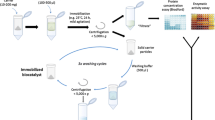Summary
We have studied the influence of several parameters (glutaraldehyde concentration, pH and contact time) on the activation of an amine silica with glutaraldehyde. In order to take interactions between parameters into consideration, we have used the Response Surface Methodology which allows us to obtain an equation (not a single estimation). The optimal conditions for glutaraldehyde activation of amine Spherosil beads were as follow: the porous silica was activated for 1 h at 25°C with an 8% (V/V) solution of glutaraldehyde at pH 6.4 these conditions were the same with RNA or CMP used as substrates.
Similar content being viewed by others
References
Anfinsen CB, Redfield RR, Choate WL, Page J, Caroll WR (1954) Studies on the cross structure, cross linkages and terminal sequences in ribonuclease. J Biol Chem 207:201–210
Box GEP, Hunter NG, Hunter JS (1978) Statistics for experimenters. Wiley and Sons, Inc. New York
Cheynier V, Feinberg M, Chararas C, Ducauze C (1983) Application of Response Surface Methodology to evaluation of bioconversion experimental conditions. Appl Environ Microbiol 45:634–639
Doehlert DH, (1970) Uniform shell designs. Applied Statistics 19:231–239
Fannin TF, Marcus MD, Anderson DA, Bergman HL (1981) Use of a fractional factorial design to evaluate interactions of environmental factors affecting biodegradation rates. Appl Environ Microbiol 42:936–943
Grasset L, Cordier D, Couturier R, Ville A (1983) Immobilization of alkaline phosphatase on silk using diazo, adsorption glutaraldehyde and azide methods: optimum pH and properties of the conjugates. Biotechnol Bioeng 25:1424–1434
Hon CC, Reilly PJ (1979) Properties of β amylase immobilized to alkylamine porous silica. Biotechnol Bioeng 21:505–512
Lanteri P, Accary A, Phan tan Luu R, Matthieu D, Longeray R (1981) Reaction de dicyclo addition des orthodihydroxymethyl diphenols. II Recherche des conditions optimales de la synthèse de tetrahydrobenzo-dipyrannes. Etude dans le cas de la dihydroxymethyl-2,5 hydroquinone réagissant sur le styrène en présence de BF3 (etherate). Bull Soc Chim France II, 415–419
Monsan P, Puzo G, Mazarguil H (1975) Etude du mécanisme d'établissement des liaisons glutaraldehyde-proteines. Biochimie 57:1281–1292
Monsan P (1977–1978) Optimization of glutaraldehyde activation of a support for enzyme immobilization. J Mol Cat 3:371–384
Monsan P (1978) Influence of the conditions of trypsin immobilization onto Spherosil on coupling efficiency. Appl Microbiol Biotechnol 5:1–11
Rigal L (1981) Thesis. Institut National Polytechnique de Toulouse
Stark GR, Stein WH (1964) Alkylation of the methionine residues of ribonuclease A in 8 M urea. J Biol Chem 239:3755–3761
Weston PD, Avrameas S (1971) Proteins coupled to polyacrylamide beads using glutaraldehyde. Biochem Biophys Res Commun 45:1574–1580
Author information
Authors and Affiliations
Rights and permissions
About this article
Cite this article
Marty, JL. Application of response surface methodology to optimization of glutaraldehyde activation of a support for enzyme immobilization. Appl Microbiol Biotechnol 22, 88–91 (1985). https://doi.org/10.1007/BF00250025
Received:
Revised:
Issue Date:
DOI: https://doi.org/10.1007/BF00250025




